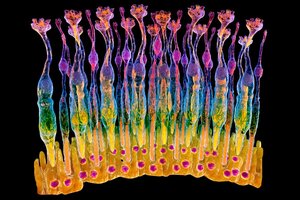Genetic mutations are identified as causing two types of hereditary blindness
The study led by Dr. Gemma Marfany describes how mutations in the NR2E3 gene lead to the death of photoreceptor cells involved in vision and pave the way for potential treatments.
The human retina is a neural tissue with two types of photoreceptor cells, rods and cones. There are mutations in the NR3E3 gene that severely affect these neurons responsible for visual perception, and cause two different types of hereditary blindness, although their mechanism of action was unknown until now.
Now, a study by the University of Barcelona, published in the journal Neurobiology of Disease, has for the first time identified the mechanisms that trigger these mutations, which alter the populations of cones and rods in the retina and cause blindness in patients. These findings may have implications for the development of potential therapies for these disorders, which currently have no cure.
"We believe that if we can prevent the activation of programmed photoreceptor death pathways, we could slow down or prevent blindness in patients", explains Gemma Marfany, professor at the UB's Faculty of Biology and Institute of Biomedicine (IBUB), who coordinated the study, led Human Molecular Genetics II research group in Institut de Recerca Sant Joan de Déu.
Researchers from the Max Planck Institute for Molecular Biomedicine (Germany) and Imperial College London (United Kingdom) have also participated in the study.
Pioneering work in single-cell RNA sequencing technology
"The function of the NR2E3 gene in human retinal development is to act on the differentiation of photoreceptor cell precursors and establish their fate: towards cones - responsible for daytime and colour vision, as well as visual acuity - or towards rods, which are responsible for low-light and black and white vision, and are responsible for peripheral vision," says Marfany, a researcher at the UB, who is also a member of the Centre for Biomedical Research Network on Rare Diseases (CIBERER) and the Sant Joan de Déu Research Institute (IRSJD).
Mutations in this gene cause two types of hereditary blindness: retinitis pigmentosa, caused by the progressive death of the rods, and S-cone syndrome, which is caused by an error in the development and differentiation of the rods, so that there is an excess of dysfunctional cones.
"When the retina does not function correctly, such as when there is not a correct proportion of photoreceptors, or they do not work or do not connect properly, a process of programmed death of these highly specialized neurons is usually activated, which ends up leading to blindness", notes Marfany.
To study the specific role of the NR2E3 gene in photoreceptor dysfunction, the researchers generated two mouse models for gene editing - one for each disease - and analysed the difference in gene expression and retinal cell types using single cell RNA sequencing (scRNA-seq).
This technique opens, in the words of the researchers, "a window into what is really happening in the retina of patients". Moreover, this is pioneering work, as there is "not much work yet on RNA sequencing of individual retinal cells because it is a neuronal tissue that is very difficult to obtain material of sufficient quality to carry out such a complex analysis", the researcher stresses.
Cones and rods are not homogeneous groups
The most important and, as the expert points out, "unexpected" result is that there is a lot of diversity within each group of photoreceptors. "Cones and rods are not two homogeneous and clearly differentiated groups of photoreceptor cells, but within each group there are many subpopulations, which show a functional specialization or a degree of differentiation clearly distinguishable by the expression of specific genes", she explains.
In this context, the NR2E3 gene mutation causes "the cone group to present a defective differentiation, with the existence of hybrid photoreceptors halfway between cones and rods, most of which end up dying", says the expert. In addition, the study also indicates that there is a group of cones that lose their identity and become rods and vice versa, rods that become cones. "This half-way differentiation and loss of identity of the photoreceptor cells leads to retinal dysfunction, and ultimately results in blindness in patients. It is important to remember that humans are visual animals, and vision loss is truly disabling", notes the researcher.
According to the UB professor, these findings open the door to the design of future treatments, since "it has allowed us to identify which signalling pathways can be intervened to improve retinal function in patients with mutations in the NR2E3 gene".
In addition, the researcher does not rule out that these pathways "could also be efficient for the treatment of other types of retinal diseases", which affect more people. However, Marfany points out that "more research is needed" to be certain.
Reference article:
Aísa-Marín, I.; Rovira, Q.; Díaz, N.; Calvo-López, L.; Vaquerizas, J.M.; Marfany, G. "Specific photoreceptor cell fate pathways are differentially altered in NR2E3-associated diseases". Neurobiology of Disease, May 2024. DOI: 10.1016/j.nbd.2024.106463

The results open the door to the design of future treatments, as they have allowed the identification of signaling pathways that could be targeted to improve retinal function in patients with mutations in the NR2E3 gene.
